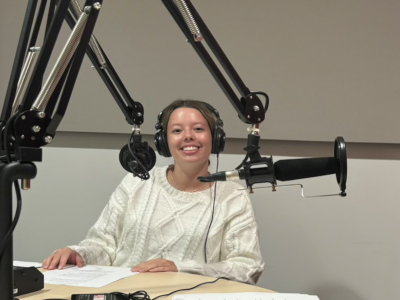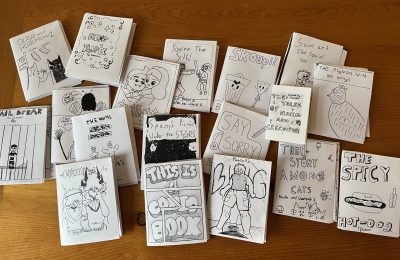
Zines created by students in the “Comics and Cartooning” mini-course.
Every spring, Carleton University invites Grade 8-11 students living in and around Ottawa to get a glimpse into what it’s like to be a university student as part of the Mini-Courses Program, and the School of Journalism and Communication is always excited to participate. This year, from April 29 to May 4, 2024, SJC hosted a series of engaging mini courses designed to immerse students in various aspects of media production and communication.
Facilitated by faculty and staff from across Media Production & Design, Communication & Media Studies, and Journalism, SJC’s 2024 mini-course lineup included courses in documentary filmmaking, visual storytelling, comics, and 3D design, each providing a unique learning experience that left a lasting impact on participants and faculty alike.
Direct Your Own Mini-Documentary: Foundations in Visual Storytelling
In the “Direct Your Own Mini-Documentary” course, 26 students from grades 8-10 were guided through the process of producing, editing, and directing their own mini-documentaries (two to two-and-a-half minutes in length).
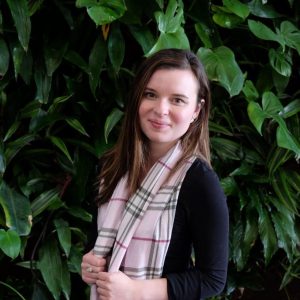
BMPD instructor Caroline O’Neill, who co-taught this mini-course with Randy Bowler.
Led by Caroline O’Neill (Instructor, BMPD) and Randy Bowler (SJC’s Digital Media Technologist), the students worked in small groups to create documentaries exploring topics such as returning to sports after an injury, the benefits of pets, and evolving reading habits. The hands-on approach encouraged students to think visually, resulting in an exciting exhibition where proud parents watched their children’s creations.
“The students we worked with came in ready to learn, have fun, and work,” said Caroline O’Neill. “Most had never met each other before, but they were all able to bring lovely storytelling out of each other.”
The students’ visual thinking started right away, as they thought about what, where, and how they could film their subjects. Students also quickly developed a sense of camaraderie, with many excited to show parents not only their own work but also that of their peers.
Comics and Cartooning
Comics and cartooning took center stage in this course, led by Prof. Benjamin Woo (COMS) and Communication PhD student Kate Fedchun. 19 students from grades 8-10 spent their week diving deep into the history and cultural impact of comics. They explored different styles and forms of comics, ultimately creating their own mini-comics and zines.
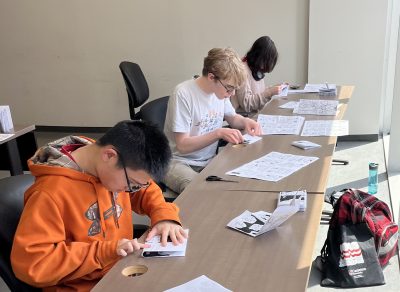
Students hard at work on their zines.
The course included drawing exercises and a unique “tournament” where students applied comic definitions to various artifacts. The highlight was a mini-con / zine festival, where students proudly displayed their work to their parents.
Woo found it rewarding to get to walk high schoolers through making their own physical media product: “At a time when so much of young people’s lives is digitally mediated, simple things like drawing with a pen and paper, folding a little booklet of your stories, and communicating directly to an audience with no platforms or advertisers getting involved can feel a little subversive.”
Visual Storytelling and Digital Tools
Prof. Katie Graham (BMPD)’s “Visual Storytelling and Digital Tools” course introduced 20 students from grades 8-10 to the principles of visual communication. Students explored how images can be used to communicate, and created compelling visual storytelling pieces using various technologies.
Through activities such as making “terrible posters” to understand design principles, they learned about composition, visual hierarchy, color theory, and typography. By the end of the week, they had produced a range of digital media projects, including photographs, stop-motion animations, and interactive stories.
Graham emphasized the importance of experiential learning in her teaching approach, incorporating elements from the first and second-year core BMPD courses. A lot of the lessons taught in “Visual Storytelling and Digital Tools” were directly adapted from key principles that students learn in the Media Production & Design program.
History of 3D
The “History of 3D” course, taught by Prof. Stéfy McKnight (BMPD), introduced 14 students from grades 8-9 to 3D design. The students learned the history and principles of 3D creation, experimented with 3D software, and created their own 3D printed models.
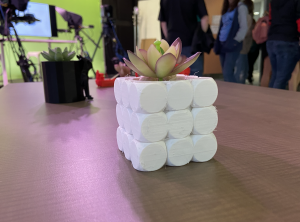
“History of 3D” students created custom succulent pots as part of the mini-course.
The course mimicked a university arts-based format, with morning lectures and afternoon practice sessions. Each student produced several 3D printed items, including a succulent pot, and gained a deeper understanding of the medium.
McKnight noted, “Teaching 3D printing to 8th and 9th graders is very fun since they already have a general understanding of the medium. What they learned over the week is how to talk about their work and know the historical and political context of the objects they are designing.”
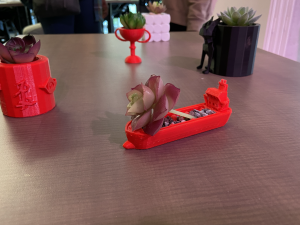
Some more of the custom succulent pots created by students.
The School of Journalism and Communication’s 2024 mini-courses offered young students a valuable platform to explore and develop their creative skills in media production and communication. These immersive courses provided practical experience and a deeper appreciation for storytelling, visual communication, and 3D design, planting a seed for them to become part of the next generation of media professionals and creative thinkers.
Monday, July 22, 2024 in Communication News, General, Journalism News, Media Production News, News
Share: Twitter, Facebook


